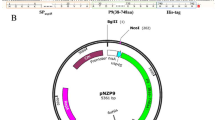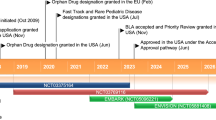Abstract
Fabry disease is an inherited lysosomal disorder caused by a deficiency of alpha-galactosidase A (α-gal A). The systemic accumulation of substrate, mainly globotriaosylceramide (Gb3), results in organ failure. Although Gb3 accumulation has been observed in an α-gal A-deficient mouse model, important clinical manifestations were not seen. The pursuit of effective treatment for Fabry disease through gene therapy, for example, has been hampered by the lack of a relevant large animal model to assess the efficacy and safety of novel therapies. Towards assembling the tools to generate an alternative animal model, we have sequenced and characterized the porcine ortholog of the α-gal A gene. When compared to the human α-gal A, the porcine α-gal A showed a high level of homology in the coding regions and located at chromosome Xq22. Cell lysate and supernatants from Fabry patient-derived fibroblasts transduced with a lentiviral vector (LV) carrying the porcine α-gal A cDNA (LV/porcine α-gal A), showed high levels of α-gal A activity and its enzymological stability was similar to that of human α-gal A. Uptake of secreted porcine α-gal A was observed into non-transduced cells and was partially inhibited by soluble mannose-6-phosphate. Furthermore, Gb3 accumulation was reduced in Fabry patient-derived fibroblasts transduced with the LV/porcine α-gal A. In conclusion, we elucidated and characterized the porcine α-gal A gene and enzyme. Similarity in enzymatic profile and chromosomal location between α-gal A of porcine and human origins may be of great advantage for the development of a large animal model for Fabry disease.






Similar content being viewed by others
References
Brady RO, Gal AE, Bradley RM, Martensson E, Warshaw AL, Laster L (1967) Enzymatic defect in Fabry’s disease. Ceramidetrihexosidase deficiency. N Engl J Med 276(21):1163–1167
Desnick RJ, Ioannou YA, Eng CM (2001) Fabry disease. In: Scriver CR, Beaudet AL, Sly WS, Valle D (eds) The metabolic and molecular bases of inherited disease. McGraw-Hill Inc, New York, pp 3733–3774
Schaefer RM, Tylki-Szymanska A, Hilz MJ (2009) Enzyme replacement therapy for Fabry disease: a systematic review of available evidence. Drugs 69(16):2179–2205. doi:10.2165/11318300-000000000-00000
Ohshima T, Murray GJ, Swaim WD, Longenecker G, Quirk JM, Cardarelli CO, Sugimoto Y, Pastan I, Gottesman MM, Brady RO, Kulkarni AB (1997) Alpha-Galactosidase A deficient mice: a model of Fabry disease. Proc Natl Acad Sci USA 94(6):2540–2544
Takenaka T, Murray GJ, Qin G, Quirk JM, Ohshima T, Qasba P, Clark K, Kulkarni AB, Brady RO, Medin JA (2000) Long-term enzyme correction and lipid reduction in multiple organs of primary and secondary transplanted Fabry mice receiving transduced bone marrow cells. Proc Natl Acad Sci USA 97(13):7515–7520. doi:10.1073/pnas.120177997
Qin G, Takenaka T, Telsch K, Kelley L, Howard T, Levade T, Deans R, Howard BH, Malech HL, Brady RO, Medin JA (2001) Preselective gene therapy for Fabry disease. Proc Natl Acad Sci USA 98(6):3428–3433. doi:10.1073/pnas.061020598
Yoshimitsu M, Sato T, Tao K, Walia JS, Rasaiah VI, Sleep GT, Murray GJ, Poeppl AG, Underwood J, West L, Brady RO, Medin JA (2004) Bioluminescent imaging of a marking transgene and correction of Fabry mice by neonatal injection of recombinant lentiviral vectors. Proc Natl Acad Sci USA 101(48):16909–16914. doi:10.1073/pnas.0407572101
Yoshimitsu M, Higuchi K, Dawood F, Rasaiah VI, Ayach B, Chen M, Liu P, Medin JA (2006) Correction of cardiac abnormalities in fabry mice by direct intraventricular injection of a recombinant lentiviral vector that engineers expression of alpha-galactosidase A. Circ J 70(11):1503–1508. doi:JST.JSTAGE/circj/70.1503
Yoshimitsu M, Higuchi K, Ramsubir S, Nonaka T, Rasaiah VI, Siatskas C, Liang SB, Murray GJ, Brady RO, Medin JA (2007) Efficient correction of Fabry mice and patient cells mediated by lentiviral transduction of hematopoietic stem/progenitor cells. Gene Ther 14(3):256–265. doi:10.1038/sj.gt.3302839
Capecchi MR (2005) Gene targeting in mice: functional analysis of the mammalian genome for the twenty-first century. Nat Rev Genet 6(6):507–512. doi:10.1038/nrg1619
Wilmut I, Schnieke AE, McWhir J, Kind AJ, Campbell KH (1997) Viable offspring derived from fetal and adult mammalian cells. Nature 385(6619):810–813. doi:10.1038/385810a0
Cibelli JB, Stice SL, Golueke PJ, Kane JJ, Jerry J, Blackwell C, Ponce de Leon FA, Robl JM (1998) Cloned transgenic calves produced from nonquiescent fetal fibroblasts. Science 280(5367):1256–1258
Wakayama T, Perry AC, Zuccotti M, Johnson KR, Yanagimachi R (1998) Full-term development of mice from enucleated oocytes injected with cumulus cell nuclei. Nature 394(6691):369–374. doi:10.1038/28615
Baguisi A, Behboodi E, Melican DT, Pollock JS, Destrempes MM, Cammuso C, Williams JL, Nims SD, Porter CA, Midura P, Palacios MJ, Ayres SL, Denniston RS, Hayes ML, Ziomek CA, Meade HM, Godke RA, Gavin WG, Overstrom EW, Echelard Y (1999) Production of goats by somatic cell nuclear transfer. Nat Biotechnol 17(5):456–461. doi:10.1038/8632
Polejaeva IA, Chen SH, Vaught TD, Page RL, Mullins J, Ball S, Dai Y, Boone J, Walker S, Ayares DL, Colman A, Campbell KH (2000) Cloned pigs produced by nuclear transfer from adult somatic cells. Nature 407(6800):86–90. doi:10.1038/35024082
Chesne P, Adenot PG, Viglietta C, Baratte M, Boulanger L, Renard JP (2002) Cloned rabbits produced by nuclear transfer from adult somatic cells. Nat Biotechnol 20(4):366–369. doi:10.1038/nbt0402-366
Zhou Q, Renard JP, Le Friec G, Brochard V, Beaujean N, Cherifi Y, Fraichard A, Cozzi J (2003) Generation of fertile cloned rats by regulating oocyte activation. Science 302(5648):1179. doi:10.1126/science.1088313
Lee BC, Kim MK, Jang G, Oh HJ, Yuda F, Kim HJ, Hossein MS, Kim JJ, Kang SK, Schatten G, Hwang WS (2005) Dogs cloned from adult somatic cells. Nature 436(7051):641. doi:10.1038/436641a
Li Z, Sun X, Chen J, Liu X, Wisely SM, Zhou Q, Renard JP, Leno GH, Engelhardt JF (2006) Cloned ferrets produced by somatic cell nuclear transfer. Dev Biol 293(2):439–448. doi:10.1016/j.ydbio.2006.02.016
Miyoshi K, Inoue S, Himaki T, Mikawa S, Yoshida M (2007) Birth of cloned miniature pigs derived from somatic cell nuclear transferred embryos activated by ultrasound treatment. Mol Reprod Dev 74(12):1568–1574. doi:10.1002/mrd.20730
Rogers CS, Hao Y, Rokhlina T, Samuel M, Stoltz DA, Li Y, Petroff E, Vermeer DW, Kabel AC, Yan Z, Spate L, Wax D, Murphy CN, Rieke A, Whitworth K, Linville ML, Korte SW, Engelhardt JF, Welsh MJ, Prather RS (2008) Production of CFTR-null and CFTR-DeltaF508 heterozygous pigs by adeno-associated virus-mediated gene targeting and somatic cell nuclear transfer. J Clin Invest 118(4):1571–1577. doi:10.1172/JCI34773
Rogers CS, Stoltz DA, Meyerholz DK, Ostedgaard LS, Rokhlina T, Taft PJ, Rogan MP, Pezzulo AA, Karp PH, Itani OA, Kabel AC, Wohlford-Lenane CL, Davis GJ, Hanfland RA, Smith TL, Samuel M, Wax D, Murphy CN, Rieke A, Whitworth K, Uc A, Starner TD, Brogden KA, Shilyansky J, McCray PB Jr, Zabner J, Prather RS, Welsh MJ (2008) Disruption of the CFTR gene produces a model of cystic fibrosis in newborn pigs. Science 321(5897):1837–1841. doi:10.1126/science.1163600
Sun X, Yan Z, Yi Y, Li Z, Lei D, Rogers CS, Chen J, Zhang Y, Welsh MJ, Leno GH, Engelhardt JF (2008) Adeno-associated virus-targeted disruption of the CFTR gene in cloned ferrets. J Clin Invest 118(4):1578–1583. doi:10.1172/JCI34599
Takahashi K, Tanabe K, Ohnuki M, Narita M, Ichisaka T, Tomoda K, Yamanaka S (2007) Induction of pluripotent stem cells from adult human fibroblasts by defined factors. Cell 131(5):861–872. doi:10.1016/j.cell.2007.11.019
Esteban MA, Xu J, Yang J, Peng M, Qin D, Li W, Jiang Z, Chen J, Deng K, Zhong M, Cai J, Lai L, Pei D (2009) Generation of induced pluripotent stem cell lines from tibetan miniature pig. J Biol Chem. doi:10.1074/jbc.M109.008938
Liao J, Cui C, Chen S, Ren J, Chen J, Gao Y, Li H, Jia N, Cheng L, Xiao H, Xiao L (2009) Generation of induced pluripotent stem cell lines from adult rat cells. Cell Stem Cell 4(1):11–15. doi:10.1016/j.stem.2008.11.013
Uenishi H, Eguchi T, Suzuki K, Sawazaki T, Toki D, Shinkai H, Okumura N, Hamasima N, Awata T (2004) PEDE (Pig EST Data Explorer): construction of a database for ESTs derived from porcine full-length cDNA libraries. Nucleic Acids Res 32(Database issue):D484–D488.doi 10.1093/nar/gkh037
Medin JA, Tudor M, Simovitch R, Quirk JM, Jacobson S, Murray GJ, Brady RO (1996) Correction in trans for Fabry disease: expression, secretion and uptake of alpha-galactosidase A in patient-derived cells driven by a high-titer recombinant retroviral vector. Proc Natl Acad Sci USA 93(15):7917–7922
Mayes JS, Scheerer JB, Sifers RN, Donaldson ML (1981) Differential assay for lysosomal alpha-galactosidases in human tissues and its application to Fabry’s disease. Clin Chim Acta 112(2):247–251
Garman SC, Garboczi DN (2004) The molecular defect leading to Fabry disease: structure of human alpha-galactosidase. J Mol Biol 337(2):319–335. doi:10.1016/j.jmb.2004.01.035
Ziegler RJ, Yew NS, Li C, Cherry M, Berthelette P, Romanczuk H, Ioannou YA, Zeidner KM, Desnick RJ, Cheng SH (1999) Correction of enzymatic and lysosomal storage defects in Fabry mice by adenovirus-mediated gene transfer. Hum Gene Ther 10(10):1667–1682. doi:10.1089/10430349950017671
Jung SC, Han IP, Limaye A, Xu R, Gelderman MP, Zerfas P, Tirumalai K, Murray GJ, During MJ, Brady RO, Qasba P (2001) Adeno-associated viral vector-mediated gene transfer results in long-term enzymatic and functional correction in multiple organs of Fabry mice. Proc Natl Acad Sci USA 98(5):2676–2681. doi:10.1073/pnas.051634498
Takahashi H, Hirai Y, Migita M, Seino Y, Fukuda Y, Sakuraba H, Kase R, Kobayashi T, Hashimoto Y, Shimada T (2002) Long-term systemic therapy of Fabry disease in a knockout mouse by adeno-associated virus-mediated muscle-directed gene transfer. Proc Natl Acad Sci USA 99(21):13777–13782. doi:10.1073/pnas.222221899
Ziegler RJ, Lonning SM, Armentano D, Li C, Souza DW, Cherry M, Ford C, Barbon CM, Desnick RJ, Gao G, Wilson JM, Peluso R, Godwin S, Carter BJ, Gregory RJ, Wadsworth SC, Cheng SH (2004) AAV2 vector harboring a liver-restricted promoter facilitates sustained expression of therapeutic levels of alpha-galactosidase A and the induction of immune tolerance in Fabry mice. Mol Ther 9(2):231–240. doi:10.1016/j.ymthe.2003.11.015
Ziegler RJ, Cherry M, Barbon CM, Li C, Bercury SD, Armentano D, Desnick RJ, Cheng SH (2007) Correction of the biochemical and functional deficits in fabry mice following AAV8-mediated hepatic expression of alpha-galactosidase A. Mol Ther 15(3):492–500. doi:10.1038/sj.mt.6300066
Nakamura G, Maruyama H, Ishii S, Shimotori M, Kameda S, Kono T, Miyazaki J, Kulkarni AB, Gejyo F (2008) Naked plasmid DNA-based alpha-galactosidase A gene transfer partially reduces systemic accumulation of globotriaosylceramide in Fabry mice. Mol Biotechnol 38(2):109–119. doi:10.1007/s12033-007-9008-5
Acknowledgements
We thank Miss Takane Takemoto and Miss Miho Hachiman for their technical help. This research was supported in part by a Grant-in-Aid for Idiopathic Cardiomyopathy Research Committee from the Ministry of Health, Labour and Welfare of Japan.
Author information
Authors and Affiliations
Corresponding author
Additional information
Makoto Yoshimitsu and Koji Higuchi authors contributed equally to this work.
Electronic supplementary material
Below is the link to the electronic supplementary material.
Supplementary Fig. 1a
(TIF 4017 kb)
Supplementary Fig. 1b
(TIF 305 kb)
Supplementary Fig. 2a
(TIF 10511 kb)
Supplementary Fig. 2b
(TIF 8861 kb)
Supplementary Table 1
DOC 43 kb)
Rights and permissions
About this article
Cite this article
Yoshimitsu, M., Higuchi, K., Fan, X. et al. Sequencing and characterization of the porcine α-galactosidase A gene: towards the generation of a porcine model for Fabry disease. Mol Biol Rep 38, 3145–3152 (2011). https://doi.org/10.1007/s11033-010-9985-5
Received:
Accepted:
Published:
Issue Date:
DOI: https://doi.org/10.1007/s11033-010-9985-5




